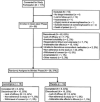Lamotrigine adjunctive therapy to lithium and divalproex in depressed patients with rapid cycling bipolar disorder and a recent substance use disorder: a 12-week, double-blind, placebo-controlled pilot study
- PMID: 21240149
- PMCID: PMC3442254
Lamotrigine adjunctive therapy to lithium and divalproex in depressed patients with rapid cycling bipolar disorder and a recent substance use disorder: a 12-week, double-blind, placebo-controlled pilot study
Abstract
Objective: To pilot the efficacy and safety data of lamotrigine adjunctive therapy to lithium and divalproex in patients with rapid-cycling bipolar disorder (RCBD) and a recent substance use disorder (SUD).
Method: Structured clinical interviews were used to ascertain DSM-IV diagnosis of RCBD, SUDs, and other Axis I disorders. Patients who did not meet the criteria for a bimodal response after up to 16-weeks of open-label treatment with lithium plus divalproex, as measured by MADRS (Montgomery-Asberg Depression Rating Scale) ≤ 19, YMRS ( Young Mania Rating Scale) ≤ 12 and GAF (Global Assessment of Functioning) = 51 for 4 weeks, were randomized to a 12- week, double-blind addition of lamotrigine or placebo to lithium plus divalproex. Primary and secondary outcomes were analyzed with ANCOVA, t-test, or chi-square/Fisher's exact.
Results: Of 98 patients enrolled into the study, 36 were randomized to receive lamotrigine (n = 18) or placebo (n ± 18), and 8 patients per arm completed the study. No patient discontinued due to adverse events. The change in MADRS total score from baseline to endpoint was -9.1 ± 11.2 in lamotrigine-treated patients versus -4.5 ± 13.1 in placebo-treated patients (p = 0.27). There were no significant differences in changes in YMRS total scores and rates of response or remission.
Conclusions: Lamotrigine adjunctive therapy was well tolerated in patients previously non-responsive to initial treatment of lithium plus divalproex. A larger study is warranted to determine the efficacy and safety of adjunctive lamotrigine versus placebo in RCBD with a recent SUD.
Figures
Similar articles
-
Lamotrigine as add-on treatment to lithium and divalproex: lessons learned from a double-blind, placebo-controlled trial in rapid-cycling bipolar disorder.Bipolar Disord. 2012 Nov;14(7):780-9. doi: 10.1111/bdi.12013. Bipolar Disord. 2012. PMID: 23107222 Free PMC article. Clinical Trial.
-
Lamotrigine combined with divalproex or lithium for bipolar disorder: a case series.CNS Spectr. 2006 Dec;11(12):915-8. doi: 10.1017/s1092852900015091. CNS Spectr. 2006. PMID: 17146405
-
Rates of remission/euthymia with quetiapine in combination with lithium/divalproex for the treatment of acute mania.J Affect Disord. 2007;100 Suppl 1:S55-63. doi: 10.1016/j.jad.2007.02.008. Epub 2007 Mar 26. J Affect Disord. 2007. PMID: 17383736
-
Bipolar rapid cycling: focus on depression as its hallmark.J Clin Psychiatry. 2001;62 Suppl 14:34-41. J Clin Psychiatry. 2001. PMID: 11469674 Review.
-
[Antipsychotics in bipolar disorders].Encephale. 2004 Sep-Oct;30(5):417-24. doi: 10.1016/s0013-7006(04)95456-5. Encephale. 2004. PMID: 15627046 Review. French.
Cited by
-
Sequential Multiple Assignment Randomized Treatment (SMART) for Bipolar Disorder at Any Phase of Illness and at least Mild Symptom Severity.Psychopharmacol Bull. 2020 May 19;50(2):8-25. Psychopharmacol Bull. 2020. PMID: 32508363 Free PMC article. Clinical Trial.
-
Rapid cycling bipolar disorder: Literature review on pharmacological treatment illustrated by a case report on ketamine.Brain Behav. 2022 Feb;12(2):e2483. doi: 10.1002/brb3.2483. Epub 2022 Jan 18. Brain Behav. 2022. PMID: 35041295 Free PMC article. Review.
-
Efficacy and safety of lamotrigine in the treatment of bipolar disorder across the lifespan: a systematic review.Ther Adv Psychopharmacol. 2021 Oct 8;11:20451253211045870. doi: 10.1177/20451253211045870. eCollection 2021. Ther Adv Psychopharmacol. 2021. PMID: 34646439 Free PMC article. Review.
-
The Black Book of Psychotropic Dosing and Monitoring.Psychopharmacol Bull. 2018 Jan 15;48(1):64-153. Psychopharmacol Bull. 2018. PMID: 29382960 Free PMC article. Review. No abstract available.
-
A placebo controlled study of quetiapine-XR in bipolar depression accompanied by generalized anxiety with and without a recent history of alcohol and cannabis use.Psychopharmacology (Berl). 2017 Aug;234(15):2233-2244. doi: 10.1007/s00213-017-4642-5. Epub 2017 May 24. Psychopharmacology (Berl). 2017. PMID: 28536866 Clinical Trial.
References
-
- Kupka RW, Luckenbaugh DA, Post RM, et al. Rapid and non-rpid cyding bipolar disorder. a meta-analysis of clinical studies. J Clin Psychiatry. 2003;64:1483–1494. - PubMed
-
- Schneck CD, Miklowitz DJ, Calabrese JR, et al. Phenomenology of rpid-cycling bipolar disorder: data from the first 500 participants in the Systematic Treatment Enhancement Program. Am Psychiatry. 2004;161:1902–1908. - PubMed
-
- Schneck CD. Treatment of rapid-cycling bipolar disorder. J Clin Psychiatry. 2006;67(Suppl. 11):22–27. - PubMed
-
- Kupka RW, Luckenbaugh DA, Post RM, et al. Comparison of rapid-cycling and non-rapid-cyding bipolar disorder based on prospective mood ratings in 539 outpatients. Am J Psychiatry. 2005;162:1273–1280. - PubMed
Publication types
MeSH terms
Substances
Grants and funding
LinkOut - more resources
Full Text Sources
Medical

